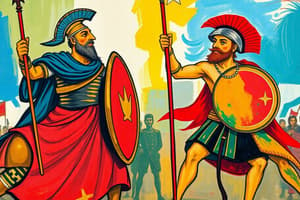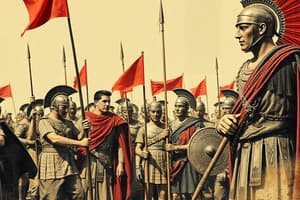Podcast
Questions and Answers
What strategic location did Carthage threaten to seize, prompting a response from the Romans?
What strategic location did Carthage threaten to seize, prompting a response from the Romans?
- Strait of Messina (correct)
- Strait of Gibraltar
- Strait of Magellan
- Strait of Hormuz
What tactic did the Romans use to gain an advantage in naval battles against the Carthaginians?
What tactic did the Romans use to gain an advantage in naval battles against the Carthaginians?
- Deploying mind-controlled ships
- Building larger ships with more firepower
- Employing grappling hooks to board enemy vessels (correct)
- Using incendiary devices to burn enemy ships
Who became the general of the Carthaginian army in Spain in 221 B.C.?
Who became the general of the Carthaginian army in Spain in 221 B.C.?
- Hannibal (correct)
- Hasdrubal
- Mago
- Scipio
What was the outcome for Hannibal's army after crossing the Alps?
What was the outcome for Hannibal's army after crossing the Alps?
Despite Hannibal's early successes, what ultimately enabled the Romans to continue fighting?
Despite Hannibal's early successes, what ultimately enabled the Romans to continue fighting?
What was the outcome of the confrontations between Roman forces and Pyrrhus?
What was the outcome of the confrontations between Roman forces and Pyrrhus?
What military strategy did the Romans adopt to improve upon the Greek phalanx?
What military strategy did the Romans adopt to improve upon the Greek phalanx?
Which term describes a victory that is achieved at a significant cost to the victor?
Which term describes a victory that is achieved at a significant cost to the victor?
What was one consequence of Rome's treatment of conquered peoples?
What was one consequence of Rome's treatment of conquered peoples?
What led to the establishment of military settlements known as coloniae?
What led to the establishment of military settlements known as coloniae?
How did the Romans’ approach to warfare differ from that of other conquerors during the same period?
How did the Romans’ approach to warfare differ from that of other conquerors during the same period?
What motivated the Romans to engage in conflict with Carthage?
What motivated the Romans to engage in conflict with Carthage?
What was the structure of a Roman legion after reorganization?
What was the structure of a Roman legion after reorganization?
Flashcards
Strait of Messina
Strait of Messina
A narrow passage between Sicily and Italy that was strategically important for controlling trade and movement. It was the site of the first clash between the Romans and Carthaginians.
Carthaginian Fleet
Carthaginian Fleet
A powerful naval force that gave Carthage an edge in the early stages of the First Punic War.
Grappling Hook Tactic
Grappling Hook Tactic
A strategic maneuver used by the Romans in the First Punic War, where they would grapple with the Carthaginian ships, board them, and engage in hand-to-hand combat.
Hannibal
Hannibal
Signup and view all the flashcards
Battle of Cannae
Battle of Cannae
Signup and view all the flashcards
What is a 'Pyrrhic victory'?
What is a 'Pyrrhic victory'?
Signup and view all the flashcards
How was the Roman army organized?
How was the Roman army organized?
Signup and view all the flashcards
What were the key elements of Roman military discipline?
What were the key elements of Roman military discipline?
Signup and view all the flashcards
What were Roman 'coloniae'?
What were Roman 'coloniae'?
Signup and view all the flashcards
How did Roman roads play a role in Roman expansion?
How did Roman roads play a role in Roman expansion?
Signup and view all the flashcards
What was Carthage's role in the Mediterranean world?
What was Carthage's role in the Mediterranean world?
Signup and view all the flashcards
What was the First Punic War?
What was the First Punic War?
Signup and view all the flashcards
Why were the Punic Wars significant?
Why were the Punic Wars significant?
Signup and view all the flashcards
Study Notes
Early Roman Republic and Wars
- Rome, from 500-300 B.C., conquered or allied with neighboring Italian tribes, eventually controlling the entire Italian peninsula by 264 B.C.
- Greek colonies in southern Italy received aid from Pyrrhus, a Greek ruler. Pyrrhus's armies twice battled and defeated Romans, but at heavy losses. Their victory came at a high cost, leading to the term "Pyrrhic victory."
- Roman military success stemmed from a strong army. Early legions used Greek phalanx tactics.
- Roman generals reorganized legions into smaller, more mobile units (6,000 men divided into 60-120 soldier units), enabling them to effectively defeat phalanxes.
- Roman soldiers (legionaries) were highly trained with strict discipline, with deserters punished severely.
- Conquered peoples were often granted some form of self-governance, partial rights, or even citizenship if they helped Rome.
- Military settlements (coloniae) were established throughout Italy, linked by roads that also served as trade routes.
Rome vs. Carthage (Punic Wars)
- Carthage, a powerful Mediterranean city, expanded its trade empire through conquest. The Romans opposed Carthage's expansion.
- The First Punic War started in 264 B.C. when Carthage threatened Sicily and the Romans sent troops. The Romans faced challenging naval warfare, but eventually developed a boarding tactic that defeated the Carthage Navy.
- The war lasted until 241 B.C. when Carthage ceded Sicily and agreed to a large indemnity payment to Rome.
The Second Punic War
- Hannibal, a Carthaginian general, invaded Italy in 219 B.C., famously marching across the Alps with his army and elephants. His army suffered significant losses crossing the Alps.
- Hannibal's forces won several key battles, including the Battle of Cannae in 216 B.C., inflicting a near-destruction of the Roman army.
- Despite the defeat, Rome rallied, raising more troops, and defeated Hannibal in a later battle.
Studying That Suits You
Use AI to generate personalized quizzes and flashcards to suit your learning preferences.




